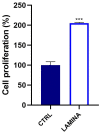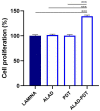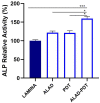Functionalization of a Cortical Membrane with a Photodynamic Protocol
- PMID: 36976057
- PMCID: PMC10057199
- DOI: 10.3390/jfb14030133
Functionalization of a Cortical Membrane with a Photodynamic Protocol
Abstract
Guided bone regeneration (GBR) comprehends the application of membranes to drive bone healing and to exclude non-osteogenic tissues from interfering with bone regeneration. However, the membranes may be exposed to bacterial attack, with the risk of failure of the GBR. Recently, an antibacterial photodynamic protocol (ALAD-PDT) based on a gel with 5% 5-aminolevulinic acid incubated for 45 min and irradiated for 7 min by a LED light at 630 nm, also showed a pro-proliferative effect on human fibroblasts and osteoblasts. The present study hypothesized that the functionalization of a porcine cortical membrane (soft-curved lamina, OsteoBiol) with ALAD-PDT might promote its osteoconductive properties. TEST 1 aimed to verify the response of osteoblasts seeded on lamina with respect to the plate surface (CTRL). TEST 2 aimed to investigate the effects of ALAD-PDT on the osteoblasts cultured on the lamina. SEM analyses were performed to study the topographical characteristics of the membrane surface, the adhesion, and the morphology of cells at 3 days. The viability was assessed at 3 days, the ALP activity at 7 days, and calcium deposition at 14 days. Results showed the porous surface of the lamina and the increase in cell attachment of osteoblasts with respect to controls. The proliferation, the ALP, and bone mineralization activity of osteoblasts seeded on lamina resulted in being significantly higher (p < 0.0001) than controls. Results also showed an additional significative enhancement (p < 0.0001) in the proliferative rate in ALP and calcium deposition after applying ALAD-PDT. In conclusion, the functionalization of the cortical membranes cultured with osteoblasts with the ALAD-PDT improved their osteoconductive properties.
Keywords: 5-aminolevulinic acid; ALP; GBR; LED; calcium deposition; lamina cortical membrane; osteoblasts; photodynamic therapy.
Conflict of interest statement
The authors declare no conflict of interest.
Figures











References
LinkOut - more resources
Full Text Sources

